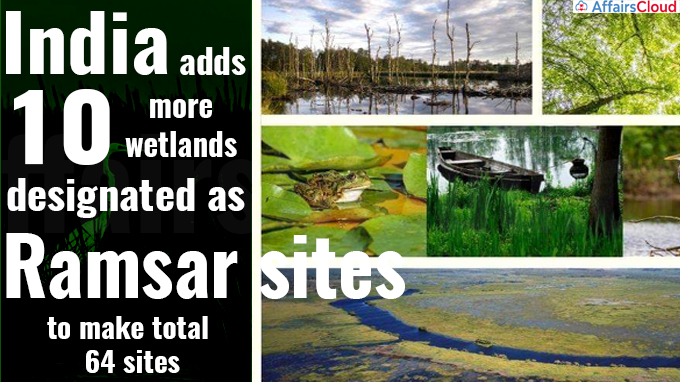
India has designated 10 more wetlands under the Ramsar Convention or the Convention on Wetlands, taking the total number of Ramsar sites in India to 64 from 54 with area coverage of 12,50,361 hectare (ha).
- The 10 new sites include 6 sites in Tamil Nadu (TN) and 1 each in Goa, Karnataka, Madhya Pradesh and Odisha.
- The information for the same was provided by Union Minister Bhupendra Yadav, Ministry of Environment, Forest and Climate Change (MOEF&CC).
Following table showing the newly inducted wetlands as Ramsar sites:
| Name of wetland | Area in Ha | State |
|---|---|---|
| Koonthankulam Bird Sanctuary | 72.04 | TN |
| Satkosia Gorge | 98196.72 | Odisha |
| Nanda Lake | 42.01 | Goa |
| Gulf of Mannar Biosphere Reserve (GoMBR) | 52671.88 | TN |
| Ranganathituu BS | 517.70 | Karnataka |
| Vembannur Wetland Complex | 19.75 | TN |
| Vellode Bird Sanctuary | 77.19 | TN |
| Sirpur wetland | 161 | Madhya Pradesh |
| Vedanthangal Bird Sanctuary | 40.35 | TN |
| Udhayamarthandapuram Bird Sanctuary | 43.77 | TN |
| Total area of 10 wetlands | 1,51,842.41 | |
| TOTAL area of 64 Ramsar Sites in India (After designation of 10 more sites as above) | 12,50,361 |
Brief of 10 new wetlands:
i.Koonthankulam Bird Sanctuary (TN): It is situated in Nanguneri Taluk of Tirunelveli district of Tamil Nadu. This is the largest reserve for breeding resident and migratory water birds in South India.
ii.Vedanthangal Bird Sanctuary (TN): Vedanthangal wetland is one of the oldest bird-protected areas located in Maduranthagam Taluk of Chengalpattu District. This freshwater wetland is a people-protected water bird area. This site is also recognized internationally, as an Important Bird and Biodiversity Area (IBA). It belongs to the Coromandel Coast biotic province.
iii.Udhayamarthandapuram Bird Sanctuary (TN): Udhayamarthandapuram Bird Sanctuary is located in the Tiruthuraipoondi Taluk of Tiruvarur district. Udhayamarthandapuram stores floodwaters during monsoon overflows and maintains surface water flow during drier periods.
iv.Gulf of Mannar Biosphere Reserve (GoMBR) in TN: It is located in the southeastern coastline of India, and is a unique marine environment rich in biodiversity. It is a first Marine Biosphere Reserve in South & South -East Asia.
- It comprises 117 species of corals, >450 species of fishes, 4 species of sea turtles, 38 species of crabs, 160 species of birds, among others.
- It is also home to several globally important and highly threatened species like the Dugong, whale shark, sea horses, Balanoglossus, 7 green sea turtle, Hawksbill turtle, dolphins, sacred chanks etc.
v.Vembannur Wetland Complex (TN): Vembannur wetland in Tamil Nadu is a human-made inland tank. Vembannur wetland forms the southernmost tip of peninsular India. This wetland forms part of the Important Bird and Biodiversity Area (IBA) and hence part of BirdLife International Data Zone. The tank and the Therrakal canal were designed to take water from River Pazhayar for irrigation 11 purposes.
vi.Vellode Bird Sanctuary (TN): Vellode Bird Sanctuary is located in the Vadamugam Vellode Village of the Perundurai Taluk, located in the Erode District. It is provincially known as Periyakulam Yeri. It is one of the 141 Prioritized wetlands in Tamil Nadu.
vii.Satkosia Gorge (Odisha): It spreads along the magnificent gorge over the river Mahanadi in Odisha. It was established in 1976 as a wildlife sanctuary.
viii.Nanda Lake (Goa): This lake is habitat for notable faunal species including Threskiornis melanocephalus (Black-headed ibis), Alcedoatthis (Common kingfisher), Hirundo smithii (Wire-tailed swallow), Metopidius indicus (Bronze-winged jacana), Haliastur indus (Brahminykite), Ardea intermedia (Intermediate egret), Vanellus indicus (Red-wattled lapwing), Microcarbo niger (Little cormorant) and Dendrocygna javanica (Lesser whistling duck).
ix.Ranganathittu Bird Sanctuary (Karnataka): It is located in Mandya district, of the state of Karnataka. It has been enlisted as one of the Important Bird Areas (IBA) in Karnataka and India by Bombay Natural History Society. It is an ecologically important riverine wetland of India with 188 species of plants, over 225 species of birds, 69 species of fishes, 13 species of frogs, and 30 species of butterflies.
x.Sirpur Wetland (Madhya Pradesh): Sirpur wetland is a significant historical wetland situated in Indore. It is an important nesting place for terrestrial and aquatic migratory & residential birds. Presently, the wetland is being developed as a bird sanctuary and ecological learning center.
About Ramsar Sites:
Ramsar Sites or Ramsar recognition is the identification of wetlands around the world, which are of international importance under The Ramsar Convention on Wetlands. The convention is an international treaty which aims at the conservation and sustainable use of wetlands.
- Named after the city of Ramsar in Iran, the convention was signed in 1971.
- The Ramsar Convention works closely with six other organizations known as international organization partners (IOPs), namely BirdLife International, International Union for Conservation of Nature (IUCN), International Water Management Institute (IWMI), Wetlands International, WWF International, and Wildfowl & Wetlands Trust (WWT).
- To be a Ramsar site, at least one of the nine criteria as defined by the Ramsar Convention of 1971 must be met by the wetland.
Recent Related News:
i.The 34th session of the International Co-ordinating Council (ICC) of the Man and the Biosphere (MAB) Programme of the UNESCO held at UNESCO headquarters in Paris, France from 13th to 17th June 2022 approved to add 11 new biosphere reserves in 9 countries to the United Nations Educational, Scientific And Cultural Organization (UNESCO) World Network of Biosphere Reserves.
ii.The Haploptychius sahyadriensis, a carnivorous land snail, India’s newest recorded snail, was discovered in the western Ghats (northern part) of Maharashtra and is endemic to the Vishalgad Conservation Reserve in Kolhapur, Maharashtra.
Static Information:
India signed the Ramsar Convention in February 1982.
i.Wetlands in UP and Gujarat serve as important spaces for migratory birds.
ii.Sundarbans in WB is the largest Ramsar site in India.
iii.Chilika lake is Asia’s largest brackish water lagoon and first Indian wetland of international importance under the Ramsar Convention.
iv.The United Kingdom (175) and Mexico (142) have the maximum Ramsar sites whereas Bolivia spans the largest area with 148,000 sq km under the Convention protection.




